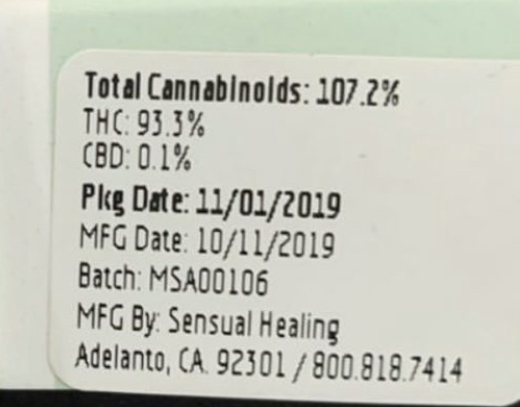Can someone explain how a product can test over 100% total cannabinods?

This is usually because of the margin of error and or the method development. This is a tad overboard. Having a +/-7% margin for official products is crazy. I’ve seen 102% max on a sample.
error in the analysis, lazy chemist not rerunning samples and adjusting curves and dilution factors
Improper dilutions/calculations that cause the sample to have a “higher potency” than the standard used is one common error with this result.
What’s sticks out more to me though is that your package says 93.3% “THC” and 0.1% CBD. Often when a lab uses GCFID and are lazy they get a “THC” % which is accounting for D9/THCA together. So if the listed cannabinoids only come to 93.4% why would you have 107.2% TAC?
Not surprised it’s from California
SD - Standard Deviation
I wrote this to someone else on a different matter but applies here.
Think of it this way… when you calibrate you say to the machine “hey, here’s a giraffe. That’s your measuring stick (internal standard). Now here’s a house. It’s 1.2 giraffes high. Ok cool, got it? Great.” your machine is now single point calibrated.
Then you get presented with a skyscraper. You give it to the machine and are like “hey, how tall is this?” The machine says, well a house was 1.2 giraffes… this has to be at least 50 giraffes. But I don’t know for sure.
The further you get away from your calibration point, the more room there is for an error. What if the giraffe is really 1.3 houses tall? Well that 0.1 error times 50 means your skyscraper measurement is at least 5 giraffes off.
Most labs can only measure cannabinoids plus or minus 10% of the reading. This is true even with state operated labs with the most expensive equipment and most experienced operators. So if you get a result of 95% d9THC, the real answer could be anywhere between 85.5% and 104.5%. So if the sample really contains 95% cannabinoids, an answer of more than 100% is entirely valid statistically even though from a common sense perspective its bogus.
Hugh
SRI
Think you may have gotten the units confused.
Aren’t Giraffes used to measure how high rather than how tall? ![]()
Just to continue what @srihugh1 said
Every measurement has a measurement uncertainty associated with it. Even the standards used to calibrate the instrument have a +/- value (uncertainty) attached to the concentration of each of the analytes in the standard. As @anon45638961 stated, you can easily have a sample measure at 102%. Yes, this is impossible because you can’t have 102 mg of cannabinoids present in a 100 mg sample… But with measurement uncertainty there is always the possibility a very pure sample could test at 102%.
Here is a link if you want to dive deep:
https://www.bipm.org/utils/common/documents/jcgm/JCGM_100_2008_E.pdf
Here’s a great write-up that I send to customers. My CBDV isolate recently tested over 100% and needless to say many people where confused.
It happens. I got back a 100.423% tac the other day.